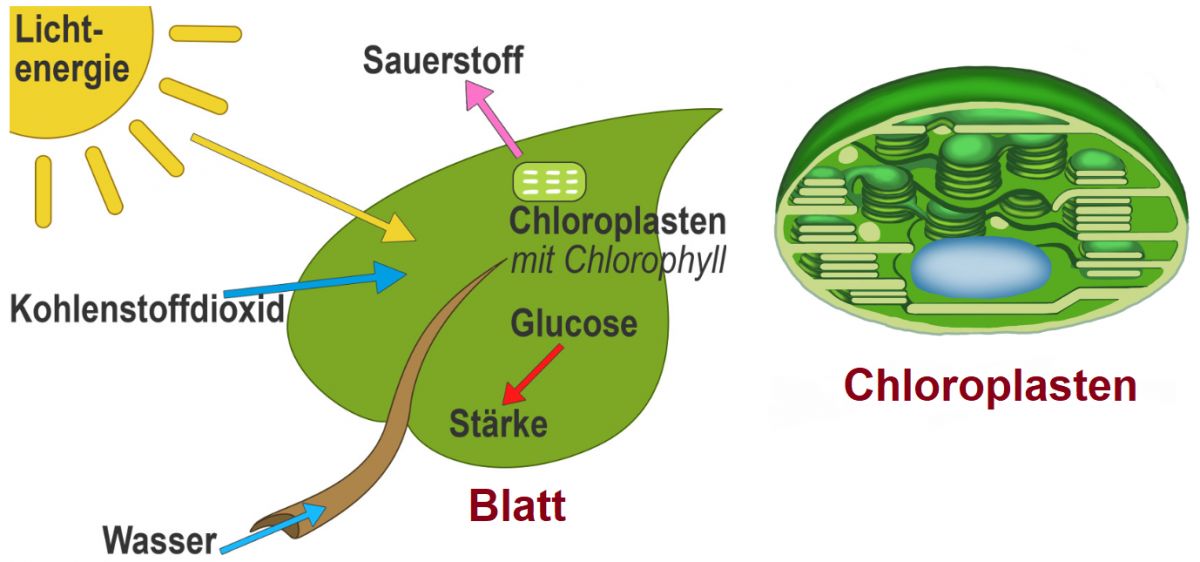Process of producing energy-rich biomolecules with the help of light energy. Responsible for this are the chloroplasts (organ cells) in which the chlorophyll (leaf green) is found. Through pigments such as chlorophyll, carotenoids and flavonoids in leaves or other green parts of plants, solar radiation is used as an energy source to produce carbohydrate compounds. In the process, carbon dioxide from the air and water are converted to the carbohydrates glucose and fructose, while elemental oxygen is released. Through the absorption of solar energy by plants, around 150 billion tonnes of carbon dioxide are bound and 400 billion tonnes of oxygen are released on earth every year.

Respiration (dissimilation)
In contrast to assimilation is the reverse process of dissimilation or respiration, in which sugar and oxygen are respired to carbon dioxide and water with the release of energy. In a cycle of 200 years, all the carbon dioxide in the atmosphere is bound in a biochemical cycle in the carbon compounds of plants, fungi and animals, to be released again as a gas when they decompose by microorganisms. From the primary carbohydrates glucose and fructose formed by photosynthesis and their storage form starch, as well as nutrient salts and trace elements absorbed by the roots, all substances necessary for the plant life process are derived (assimilates, secondary plant substances). Nutrient and water transport are separated in the plant. Respiration is the counterpart of photosynthesis, in which oxygen is consumed and carbon dioxide is released.
Transport of sugar
The active transport of the sugar from the leaves through the plant's guiding tissue takes place in the transport form of sucrose through the phloem. Together with the xylem, the phloem forms the two-layered tissue. The passive transport of water with the transpiration suction from the roots to the stomata of the leaves takes place through the xylem. Excess sugar is stored by the phloem in the berries, stem and roots. In the berries, the influx of water is blocked after the berry reaches full size to prevent the berry from bursting due to the strong osmotic effect of the sugar. Important factors for optimal photosynthesis and sugar production are sufficient sunlight, warm temperatures (ideal for leaves is 15 to 30 °C), a regulated water balance with a balanced relationship between water withdrawal and water storage capacity in the soil, as well as sufficient humidity (optimal 60 to 70%).
Nutrients
Important nutrients for plants are boron, iron, magnesium, sulphur and nitrogen. These are essential for the functioning of the chlorophyll, which absorbs and converts the energy of the sun so that photosynthesis can be set in motion. Carbon dioxide is absorbed through small closable pores (stomata) in the epidermis of the undersides of the leaves. The oxygen and water vapour produced during photosynthesis is also released through these pores. The biochemical process of photosynthesis is, so to speak, the first step in winemaking.
Sugar conversion
The yeasts convert the plant-produced sugar into alcohol and carbon dioxide during fermentation. Ultimately, the cycle is completed in humans through the consumption of wine, where the alcohol is burned in the metabolism and converted back into water, energy and carbon dioxide. Maximising photosynthetic performance is the central goal of many viticultural measures, such as targeted foliage care, as this directly determines the level of sugar storage in the grapes. Photosynthesis ceases during heat stress (above 40 °C) and drought.
Picture: © www.sofatutor.com
Voices of our members

Using the encyclopaedia is not only time-saving, but also extremely convenient. What's more, the information is always up to date.
Markus J. Eser
Weinakademiker und Herausgeber „Der Weinkalender“